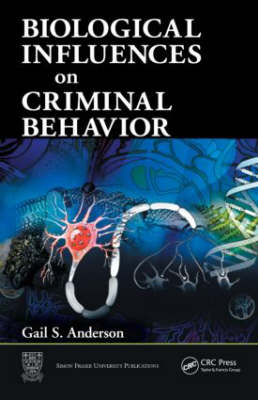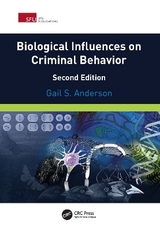
Biological Influences on Criminal Behavior
Crc Press Inc (Verlag)
978-1-4200-4331-0 (ISBN)
- Titel erscheint in neuer Auflage
- Artikel merken
In reviewing introductory texts available to criminologists, one is left with the impression that biological factors are irrelevant to the formulation of criminal behavior. Where biology is mentioned at all, it receives infinitesimal coverage. This dearth of attention could at one time be blamed on shoddy research and the legitimate fear that evidence gathered along this path would be used to support eugenics extremists. However, in the past 20 years, tremendously valuable work has been accomplished that legitimately correlates biological factors such as genetics, biochemistry, diet, and brain disease to criminal behavior. Biological Influences on Criminal Behavior fundamentally questions the way most criminologists attempt to explain, let alone ameliorate the problem of human criminal behavior. Written by Gail Anderson, a highly respected expert in forensics, who also brings a much-needed biological background to the task, this resource champions contemporary biological theory by introducing criminologists to areas of research they might not otherwise encounter.
Dr. Anderson discusses basic biological concepts such as natural selection and evolution in relation to behavior, and considers genetic factors including patterns of inheritance, sex-linked traits, and propensities toward aggression. She explores studies on hormonal effects, as well as brain chemistry, and delves deeply into organic brain dysfunction. She also looks at investigations into fetal conditions and birth-related difficulties, as well as research on nutrition and food allergies. While it is steeped in scientific research, the material is presented in a way that does not require a scientific background.
The author does not suggest that biology plays the major role in criminal behavior; however, her carefully researched work does prove that we can gain a far deeper and more useful understanding when we objectively assess all of the factors involved.
A professor of forensic entomology in the School of Criminology at Simon Fraser University, Gail S. Anderson has a Ph.D. in medical and veterinary entomology. She serves as a forensics consultant to the RCMP and city police across Canada. Among her many accolades, she was listed in TIME magazine as one of top five innovators worldwide in criminal justice and recently received the Derome Award from the Canadian Society of Forensic Sciences.
Each chapter includes an introduction, conclusion, and questions for further study.
Introduction to Biology and Crime
The Question of Biology, Crime, and the Environment, The Promise of Biological Research, Further Cautions, The History of Biology and Crime
Basic Biological Concepts
Natural Selection, Behavior in Humans and Other Animals, Innate Behaviors, Learned Behaviors, Evolution and Behavior
Genetic Concepts
Introduction to Genetics, Genetics: The Study of Patterns of Inheritance, Linked Genes, Sex-Linked Traits, Incomplete Dominance, Co-dominance, Pleiotropy, Epistasis, Polygenic Inheritance, Recessive Alleles in the Population, Aggression
Introduction to Genetic Predispositions for Behavior
Misconceptions about Genetics, Misconceptions about Animal Cloning, Misconceptions about Human Cloning, Does All Crime Have the Same Single Cause? XYY Man: Truth and Fallacy, Problems with Experimental Design, Introduction to Twin Studies, Dizygotic Twins, Monozygotic Twins, Explanations for Twin Coincidences, Using Twins to Study Genetic and Environmental
Influences on Behavior
Evidence for Genetic Predispositions for Criminogenic Behavior
Twin Studies, Problems with Twin Studies, Similar Environments, Zygosity, Differences in Monozygotic Twins, Sample Size, Different Countries, Political Bias, Summary of Twin Studies, Identical Twins Reared Apart, Adoption Studies, Mednick’s Danish Adoption Studies, Some Caveats to Mednick’s Adoption Studies, Bohman’s Stockholm Adoption Studies , Further Genetic Studies, Type II Alcoholism, Conduct Disorder, Attention Deficit Hyperactivity Disorder, Aggression
Hormonal Effects on Behavior
The Functions of Hormones, Testosterone, Natural Testosterone Levels in Aggressive Men, Serotonin and Testosterone, Increasing Testosterone, Chemical and Physical Castration, Other Androgen Activity, Premenstrual Syndrome and Crime, Growth Hormones, Cortisol, Other Hormones, Thyroid Hormones, Adrenalin
Pregnancy and the Effects of Birth
Birth Complications, Fetal Development and Diet, Fetal Alcohol Spectrum Disorder, Maternal Smoking, Maternal Age, Fetal Maldevelopment and Minor Physical Anomalies, Other Birth-Related Difficulties, Twins, Maternal Rejection
Brain Chemistry
Introduction to Neurotransmitters, The Mechanism of Action, Serotonin, Serotonin and Suicide Attempts, Serotonin and Aggression, Serotonin and Impulsivity, Serotonin and Antisocial Personality Disorder, Serotonin Binding Sites, Serotonin Precursors, Serotonin in the Courts, Norepinephrine, Dopamine, Monoamine Oxidase (MAO), MAO and Aggression, MAOA and Child Abuse, Body Build and Antisocial Behavior, Other Factors
Organic Brain Dysfunctions: Part I
Head Injury, Frontal Lobe Injury, Frontal Lobe Injury and Crime, Damage to Other Regions of the Brain, Treatment and Legal Issues, Psychosurgery
Organic Brain Dysfunctions: Part II
Brain Structure and Function, Structural Brain Imaging, Computer Tomography, Studies Using Computer Tomography, Magnetic Resonance Imaging, Studies Using Magnetic Resonance Imaging, Functional Brain Imaging, Positron Emission Tomography, Studies Using Positron Emission Tomography, Single Photon Emission Computed Tomography (SPECT), Studies Using Single Photon Computed
Emission Tomography
Diet, Toxins, and Food Additives
Hypoglycemia (Low Blood Sugar), Glucose and Serotonin, Dietary Tryptophan and Serotonin, Diet and Hormonal Changes, Influence of Lead as a Neurotoxin, Manganese, Heavy Metals and Crime, Vitamins/Minerals, Fat in the Diet, Fatty Acids, Food Additives, Food Allergies, Diet and Overall Behavior
Epilogue
| Erscheint lt. Verlag | 2.11.2006 |
|---|---|
| Zusatzinfo | 1 Tables, black and white; 7 Illustrations, black and white |
| Verlagsort | Bosa Roca |
| Sprache | englisch |
| Maße | 156 x 235 mm |
| Gewicht | 612 g |
| Themenwelt | Naturwissenschaften ► Biologie |
| Recht / Steuern ► Strafrecht ► Kriminologie | |
| ISBN-10 | 1-4200-4331-5 / 1420043315 |
| ISBN-13 | 978-1-4200-4331-0 / 9781420043310 |
| Zustand | Neuware |
| Informationen gemäß Produktsicherheitsverordnung (GPSR) | |
| Haben Sie eine Frage zum Produkt? |
aus dem Bereich



